Saturday, March 28th, 2009
Brooklyn DIY Premier MOMA Feb 25, 2009
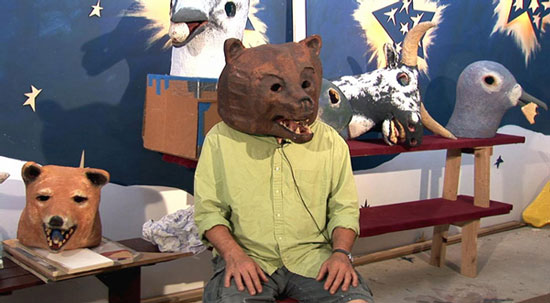
IMAGE of: Mike Ballou interview
MEMORY LANE

Interviewees
THE MOMA PREMIER
Long story short, Erika couldn’t make it and I went with a new filmmaker friend who is about as far away from the Williamsburg art scene as my new teaching job at Bergen Community College, in Paramus NJ. Gregg Biermann is way cool and he’s a filmmaker so, I thought he could help me be objective when I inevitably would get caught up in recognizing people and places or remembering if I was at some opening or party.
Marcin Ramocki introduced his film, Brooklyn DIY, at the Museum of Modern Art. He had that self-effacing, open quality that Williamsburg artists had and obviously still have so, I was ready to go down memory lane.
Whether I was watching old footage of Test Site mega-parties or succinct, provocative interviews with artists like Ebon Fisher and Ward Shelley, I was glued. The film had an incredibly tough challenge: approximately fifteen years, artists, art making, art in every style and medium possible, community, gentrification, freedom, change, artist run venues, renegades, real estate, documentation and lack of documentation, memory and it’s fallibility, the list of obstacles to creating an accurate film about this subject seemed insurmountable. And here’s the topper – how to make this film an artwork – a living thing that is about the present integrated with the past. With all the obstacles Ramocki faced he also had the best resources any filmmaker could ask for, a bunch of artists. Matt Freedman opened the film with a performance of drawing the history of Williamsburg before the artists came on a white board while Tim Spelios played a drum. Mike Ballou did the majority of his interview wearing a paper maché bear head. (Ken Burns would pay cash money for that.) Amy Sillman was insightful and didn’t mince words while petting her dog. Joe Amhrein, who always seems at ease because of his sincerity and dedication to art. Wild loft party footage. Aron Namenwirth and Nancy Horowitz sitting beside an art installation of Zoe Sheehan Saldaña’s plants growing under fluorescent lights. And I save him for last so you can bow your heads when I invoke the name, “Gene Pool”.
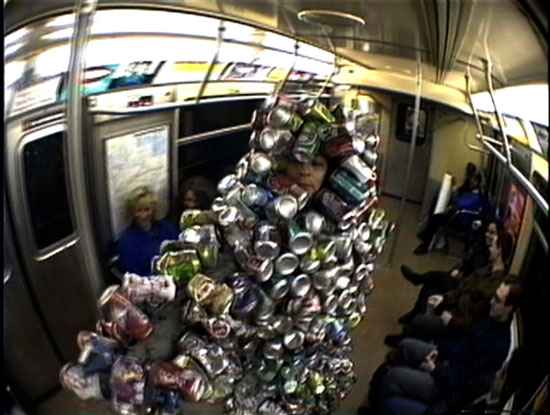
Gene Pool
Afterward, my present tense colleague, Gregg liked it. I was in a fog. I really wasn’t sure what I thought about the film objectively as a documentary. The audience was packed with Williamsburg artists. All of the well-known characters were there, only a few were missing, the critics and writers attended, and of course the Williamsburg artists were there in true form; Williamsburg doesn’t dress up even for MOMA, and they always look great. Part of my fog was nostalgia and part was that the film was stirring up feelings of being inspired. That time was inspiring. The participants were inspired. Clearly Marcin Ramocki was inspired and submerged himself in the material for two years and sunk his retirement account into it, but that’s nothing any artist wouldn’t do, right?
When it was over I didn’t go to the after party. I guessed that the conversation mixed with beer could go a number of ways, of course a lot of praise for Marcin’s hard work and dedication, which he deserved, and opinions on the quality of the film? Would arm wrestling ensue? Would this be Jackson Pollock and Barnett Newman at the White Horse? If any crowd could do that this one could. Other responses would obviously be about accuracy or treatment of different aspects of the scene. I went home and emailed Marcin asking for an interview.
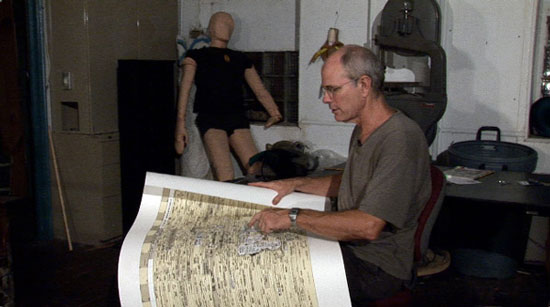
Ward Shelley showing a “timeline” of the history of the Williamsburg art scene.
THE INTERVIEW
We made arrangements to meet at Fanny’s restaurant on Graham Avenue. When Marcin politely tried to give me directions my Williamsburg attitude popped up as I quickly told him that I’ve lived here forever and I knew the way. Did I mention that Williamsburg artists wear time spent in the trenches like Purple Hearts?
Marcin Ramocki is a media artist, professor, curator, he ran the art space, vertexlist, for five years and has made two feature films. In his artwork he is interested in collecting groups of information so, the segue into organizing historical data into a documentary film is a natural step for him. His approach to organizing this sort of information is not from an analytical perspective even though he does have an interest in mathematics. We talked about Mark Lombardi’s drawings of diagrams of cons
piracies as having a relationship to the way he parses information into art.
When he gathers information and composes it into an art work he is both sensitive and practical. He chooses the medium that is appropriate for the subject and figures out how best to achieve it. He has as much as he can afford time and money wise and in the end utilizes what he has available. He gave two years, his retirement fund and his dedication to this film. He recognizes that there may be more to cover on the subject so, as well as seeing his project as complete in its own rite, it can also function as inspiration for hopefully more attention to the Williamsburg art scene. Ramocki emphasized, “This obviously is not the final historic story that everybody will have to follow. It is just one story of certain communities. So, I don’t want people to think that just because I didn’t include something it’s a final word. I’m looking forward to all these other aspects of the story to be covered by someone else because obviously I can’t. Probably if I made it the goal of my life to make a ten hour documentary about the Williamsburg art scene I could maybe do it, but within the framework of what I started, I couldn’t so, I just want people to be aware of that and instead of thinking why wasn’t so and so in it they should think ‘hey why don’t I make something about so and so myself’ because that’s the whole idea of it. I’m just another guy living here. I don’t have any money and I made this with my salary and my retirement fund which I don’t have any more. That’s all there is to it. An idiosyncratic story of Williamsburg. I personally believe that I at least touched upon the important things that were formative.”
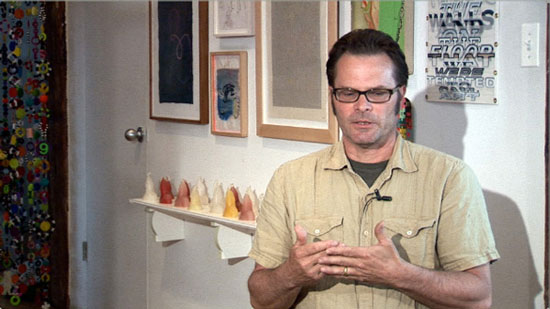
Joe Amrhein
The interviews that framed the historical footage in the film; Ebon Fisher, Amy Sillman, Mike Ballou, Joe Amhrein, Ward Shelly, Jude Talllichet, Matt Freeman, Ken Butler, etc., were wonderful. As Ramocki said at the premier, Williamsburg artists aren’t shy. Ramocki said that the interviews that became performances such as Mike Ballou talking with a bear head on and Ken Butler demonstrating his instruments occurred naturally. The stories of filming the interviews were charming and the ones that got away were good to know about. One story Ramocki recounted about an interview he would’ve liked in the film was the guy who owns De Vito Paints on Graham Ave. “Originally his customers were people from the Italian community who painted their houses for communion celebrations, then there was a period when no one bought paint. When the artists came it was the gallerists coming in to buy paint for their walls. He told the story of this area though sales of house paint! And I thought ‘wow this could be the bridge between the community that was here before, to the new community of artists’, but he said he wouldn’t do it. I think he just didn’t like being on camera.” Some other people were just camera shy so, some of them ended up being narrators. Eric Heist, of Momenta, who doesn’t appear in the film was absent because of scheduling problems. Ramocki also talked about additional footage of Joe Amrhein discussing Mark Lombardi’s work, that didn’t make the final cut because it felt like a separate subject and became overly dramatic due to Lombardi’s suicide.
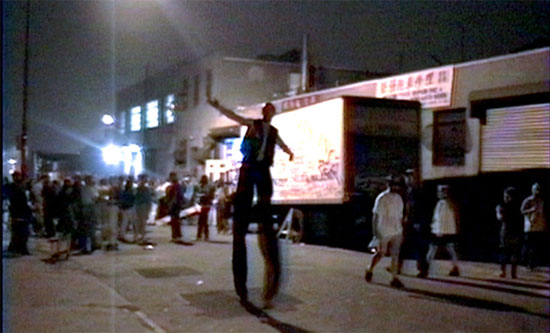
Test Site
ANTHROPOLGY OF A CULTURE
Ramocki was very aware of the vastness of his subject and the challenge of “representing the different ‘tribes‘ of Williamsburg” and he acknowledged that he had his own proclivities because of affiliation with his ’tribe’.
When I asked him what he hoped the audience outside the art world would take away from his film he said, “When I was doing the interviews I would tell them to not assume that everybody knows what we’re talking about. That was why I basically sampled different little pockets of Williamsburg and made stories. Obviously I couldn’t cover eveything. I made representative stories and themes. We’ll see, but hopefully they’ll get a sense of this homemade artist community that really can happen in any city with a little luck. Berlin is certainly a similar community and I got an email from someone in Toronto who wanted to see it because he said that they have a couple of wanna be Williamsburgs in Toronto so, they want to see what I have to say. And I think its true that a lot of large cities have versions of Williamsburg. So they’re probably going to get a kick out of it. There’s sufficient amount of fun and party for most people to enjoy it.”
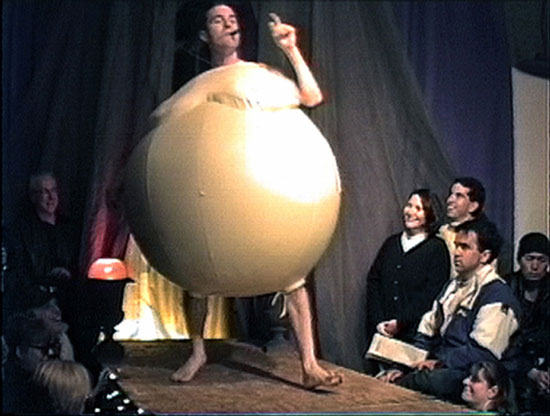
Giglio
Given seven to ten more minutes of film, he would’ve liked to have seen a deeper discussion of the artists in relationshihp to and the pre-existing neighborhood. Since there was so much to cover regarding the art scene and its relationship to the time, location and economic environment, he affectionately said he made the choice to focus on the artists and how they became a community, “My goal was to show this funny community. This happy, funny place.”
He described the process of making the film as a collaboration. He gave great credit to his editor Jessie Stead for her expertise, wittiness and female perspective on editing. He praised Lalo Molina the director of photography. And noted the communal spirit of the crew and subjects as being key in the realization of the project. He humbly added, “This is just one film from one poor Polish guy.” When asked who encouraged him most he responded, “Everybody was into being a part of the film and encouraging the making of it. From the moment Mike Ballou opened the archives of Four Walls. Obviously it needed to be done. There was definitely a need in the community to do it. I don’t know if I was the best person to do it, but there was talk about this person and that person making a documentary, but I was the one to do it. So, I guess my little documentary is the first after all.” We ended by talking about rumors concerning a “real documentary” being made with a “real producer from Hollywood” with “real money” to which Ramocki added, “I feel comfortable being ‘unreal”.”
All photos are stills from “Brooklyn DIY”.
http://www.ramocki.net/brooklyndiy.html